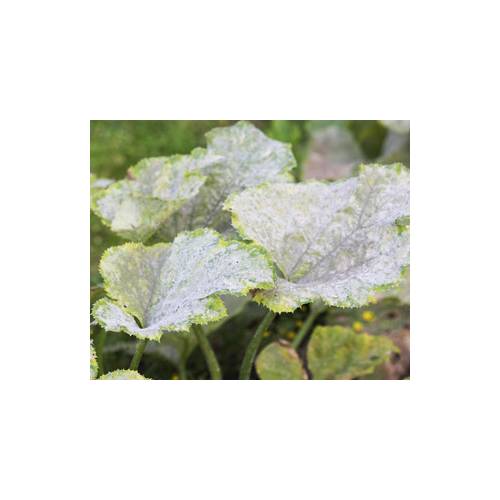
Fungus
Powdery mildew
- Details
-
It is a very common disease. It is annoying from an aesthetic point of view rather than being dangerous. Powdery mildew does not threaten the life of the plant but it can reduce its productivity and flowering.
The symptoms
The leaves become covered in a white powder, which is easily rubbed off using the fingers. The white powder has a smell very reminiscent of mushroom. A light infestation will only affect the oldest leaves. The heavier infestations will also affect the young foliage, the flower buds and the stems. The plant can end up being covered by this white powder and loose its vigour and flower less.
Lifecycle
Powdery mildew is caused by a pathogenic fungus whose microscopic germs wait for favourable conditions before developing on the surface of the leaves. They need both warmth and humidity for them to become active. The microscopic germ sends out its filaments, which implant themselves in the cells of the leaf that it is living on. Its growth is very rapid as long as the conditions are right. It the conditions become unfavourable then its development will be halted and resumed later. At the start of an infestation, small white spots appear on the surface of the leaves. This white powder will spread quickly over a few weeks especially towards the end of the summer.
How to fight it
The fight against powdery mildew is really only necessary for aesthetic reasons on plants that are particularly susceptible (asters, marrows). It is an opportunistic disease that attacks the weakened parts of plants that are at the end of their life. Removing the most affected parts of the plant is a good way of reducing the spread of powdery mildew. Spraying with a sulphur based or bouillie bordelaise solution is also a good treatment. You can also use milder products like horsetail extract or garlic to treat powdery mildew. Whatever treatment you decide on, apply it at the first signs of attack to be most effective.
How to avoid it
Even if it is impossible to protect fully against this disease, there are some things that can be done to reduce its effect. The best method to prevent powdery mildew is to plant disease resistant varieties. In general today’s varieties tend to be much more resistant than those in bygone days. Otherwise, grow susceptible plants in an area that is not favourable to the proliferation of the disease: grow the plants in a part of the garden where there is plenty of air circulation and water does not remain for a long time after the rain.
Information
Powdery mildew is not transmitted between different types of plant. Even if the symptoms of the disease appear the same on the aster, marrows and maples, the actual strain of the powdery mildew is specific to each plant. Therefore, a marrow with its leaves covered in white cannot pass the disease on to the neighbouring asters. However, if the marrow has caught the disease it is because the conditions are favourable for its proliferation so the chances are that the asters will soon have their own form of powdery mildew! - Photos (1)

